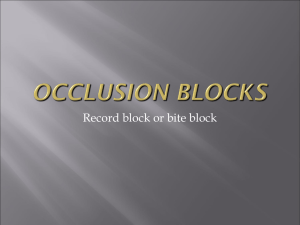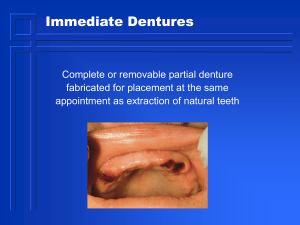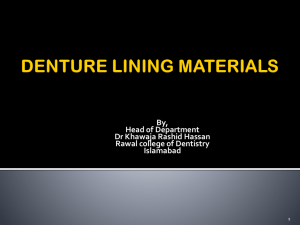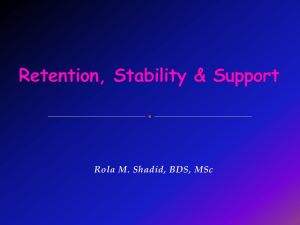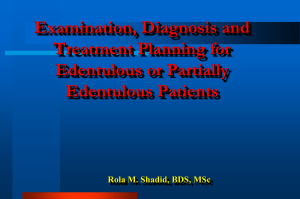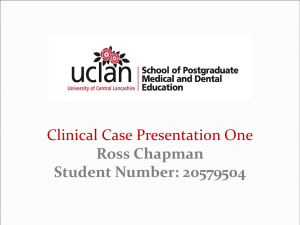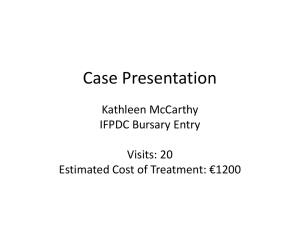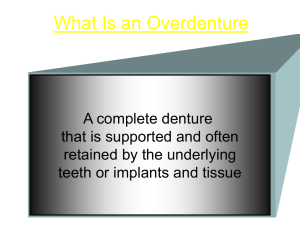OCR Document
advertisement
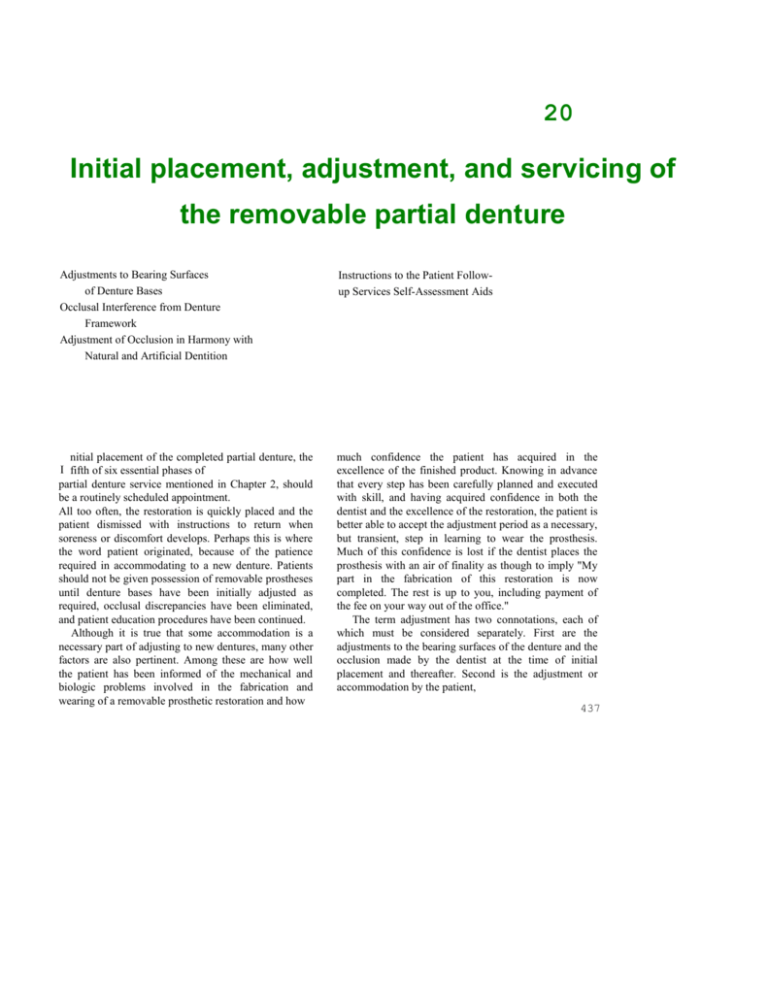
20
Initial placement, adjustment, and servicing of
the removable partial denture
Adjustments to Bearing Surfaces
of Denture Bases
Occlusal Interference from Denture
Framework
Adjustment of Occlusion in Harmony with
Natural and Artificial Dentition
Instructions to the Patient Followup Services Self-Assessment Aids
nitial placement of the completed partial denture, the
I fifth of six essential phases of
partial denture service mentioned in Chapter 2, should
be a routinely scheduled appointment.
All too often, the restoration is quickly placed and the
patient dismissed with instructions to return when
soreness or discomfort develops. Perhaps this is where
the word patient originated, because of the patience
required in accommodating to a new denture. Patients
should not be given possession of removable prostheses
until denture bases have been initially adjusted as
required, occlusal discrepancies have been eliminated,
and patient education procedures have been continued.
Although it is true that some accommodation is a
necessary part of adjusting to new dentures, many other
factors are also pertinent. Among these are how well
the patient has been informed of the mechanical and
biologic problems involved in the fabrication and
wearing of a removable prosthetic restoration and how
much confidence the patient has acquired in the
excellence of the finished product. Knowing in advance
that every step has been carefully planned and executed
with skill, and having acquired confidence in both the
dentist and the excellence of the restoration, the patient is
better able to accept the adjustment period as a necessary,
but transient, step in learning to wear the prosthesis.
Much of this confidence is lost if the dentist places the
prosthesis with an air of finality as though to imply "My
part in the fabrication of this restoration is now
completed. The rest is up to you, including payment of
the fee on your way out of the office."
The term adjustment has two connotations, each of
which must be considered separately. First are the
adjustments to the bearing surfaces of the denture and the
occlusion made by the dentist at the time of initial
placement and thereafter. Second is the adjustment or
accommodation by the patient,
437
Chapter
20
Initial placement, adjustment, and servicing of the removable partial denture
A
439
B
c
Fig. 20-1 A, Tissue side of finished bases should be carefully inspected, and surface irrc15ularities or
sho.rp projections "hould be elimirmtt:d when found. "Entire tissue surfaces of bases should be
dried and coated with thin cuat vf pre__ure indicator paste USing stiff-br1stle
brush or Q-tip. Brush marh "hould be evident and run anteroposteriorly. Thick application of
indica lor pu_t_ will give false information regardless of accuracy of denture base. 8, Denture should be
dipped in cold watpr before placement in patient's mouth to prevent paste from stickin15 to oral
li_liut:_. After careful seating of denture, patient should close firmly on cotton rolls for few
seconds. C, D,mture is r{unoved and paste is interpretcd for pressure spots. Note that bru"h
markg have been eliminated, ;vhich indicates that base is contactino tb:5ue::; vf ba_al _eat_
throughout. Black arrow points to potential pressure spot because paste has been eliminated from
the area. Swab stiCK points to area where paste was eliminated in placing and removing the
c!pnhlre This particular area is difficult to evaluate and should not be relieved unless sorcncss "FFears.
Ho;vever, area adjacent to abuhnent should be sparingly relievt:U. Several placements of demure are
usually necessary to evaluate accuracy of bases.
materials, many denture base materials leave much to be
desired in this regard, and the element of technical error
is always present. It is therefore essential that
discrepancies in the denture base be detected and
corrected before the tissues of the mouth are subjected
to the
stress of supporting a prosthetic restoration. One of our
major responsibilities to the patient is that trauma be
always held to a minimum. Therefore the appointment
time for the initial placement of the denture must be
adequate to permit such adjustment.
440 McCracken's removable partial prosthodontics
OCCLUSAL INTERFERENCE FROM DENTURE
FRAMEWORK
Any occlusal interference from occlusal rests and other
parts of the denture framework should have been
eliminated before or during
the establishment of occlusal relations. The
denture framework should have been tried in the mouth
before a final jaw relation is established, and any such
interference should have been detected and eliminated.
Much of this n__d not _xist it mouth pr_parations and
the design of the denture framework are carried out with
a specific treatment plan in mind. In any event, occlmal
interference from the framework itself should not
ordinarily require further adJw:tment at the time the
finished denture is initially placed. For the dentist to
have sent an impre__ion or ca5t_ of the patient'5 mouth
to the laboratory and to receive a finished partial
denture prosthesis without having tried the ca!:t
framework in the mouth is a dereliction of responsibilily
to the patient and the profession.
ADJUSTMENT OF OCCLUSION IN HARMONY
WITH NATURAL AND ARTIFICIAL DENTITION
The final step in the adjustment of the partial denture at
the time of initial placement is the adjustment of the
occlusion to harmonize with the natural occlusion in all
mandibular QxcurS1Ons. When opposing partial
dentures are placed concurrently, the adjustment of the
occlusion will paralleL to some extent the adjustment of
occlusion on complete dentures. This is particularly true
when the few remaining natur:;tl teeth :;tre out of
occlusion. But whQrQ onQ or more natural teeth may
occlude in any mandibular position, those teeth will
influence mandibular movement to some extent. It is
necessary tnerefore tnat tne artificial dentition on the
partial denture be made to harmonize with whatever
natural occlusion remains.
Occlusal adjustment of tooth-supported removable
partial dentures may be performed accurately by any of
several intraoral methods.
It has been our experience, however, that occlusal
adjustment of distal extension removable partial dentures
is accomplished more accurately by use of an articulator
than by any intraoral method. Because distal extension
denture bases will exhibit some movement under a
closing force, intraoral indications of occlusal
discrepancies, whether by inked ribbon or disclosing
waxes, are difficult to interpret Distal
extension dentures, positioned on remounting
casts, can conveniently be related to' the articulator with
new, nonpressure interocclusal records, and the
occlusion can be adjusted accurately at the appointment
for initial placement of the dentures (Fig. 20-2).
The methods by which occlusal relations may be
established and recorded have been discussed in Chapter
17. In this chapter the advantages of establishing a
functional occlusal relationship with an intact opposing
arch have been discussed, along with the limitations that
exist to perfecting harmonious occlusion on the finished
prosthesis by intraoral adjustment alone. Even when the
occluBion on two opposing partial dentures is adjusted,
it is bc_t that one drch be considered an intact arch and
the other one adjusted to it. This is accomplished by first
eliminating any occlusal interference to mandibular
movement imposed by one denture and adjusting any
opposing natural dQnhhon to accommodate the
proBthetically supplied teeth. Then the opposing partial
denture is placed, and occlusal adjustments arc made to
harmonize with both the natural dentition and the opposing dQnture, which is now considQrQd part of an intact
dental arch. Which denture is adjusted first and which
one is made to occlude with it is somewhat arbitrary,
with the following exceptions: If one partial denture is
entirely toothsupported emd the other hdS d tls:o;uc:5upporled basQ, thQ tooth-supported denture is
adjusted to final occlusion with any opposing natural
teeth, and then that arch is treated as an intact arch and
the opposing denture adjusted to occlude with it. If both
partial dentures are entirely tooth-supported, the one that
occludes with the most natural teeth is adjusted first, and
the second denture then adjusted to occlude with an
intact arch. Tooth-supported segments of a composite
partial denture (tooth- and tissue-supported) are
Chapter
20
Initial placement, adjustment, and servicing of the removable partial denture
A
B
c
D
441
!;
Fig. 20-2 Sequence of laDoratOry and clinical pruc",uur",s for correction of occlmml
discrepancies as a re_mlt of processing restorations. A, Maxillary mm;ter ca_l ha1> been removed
fron_ inde"ed mountino on "rticuloJor, and bag" of cagt has b""n covered with tinfoil or
separating medium before investing procedure. B, Proce55ed maxillary restoration and master cast is
recovered intact from investing medium. C, Restoration and indexed cast is attached to original
mounting with sticky wax. RemountinB jiB ig aHach"d to lower member of articulator.
D, Patty of quick-setting stone is placed on remount jig just thick enough to record occlusal
and inch:;;J1 _mf;Jce_ when articulator is closed. Original face-bow record is thus preserved. JO,
P"cc-bow rocord is trimm"d and identified with patient'_ name, articulator number,
hori2ont,,] "rId ]Meral condybr ;JdjlJ_tment_, and date.
Continued
likewise adjusted first to harmonize with any opposins
natural dQntition. The final adjustment
of occlusion on opposing tb:me-supported base:>
is usually done on the mandibular denture because this is
the moving member, and the occlusion is made to
harmonize with the maxillary denture, which is treated as
part of an intact arch.
Intraoral occlusal adjustment is accomplished by use
of some kind of indicator and suitable
lIlounled poi:nb and burs. Diamond or other abrasive
points must be used to reduce enamel,
porcelain, and metal contacts. These also may be
used to reduce plastic tooth surfaces, but burs may be
used for plastic with greater effectivene55. Articulation
paper may be used as an indicator if one recognizes that
heavy interocclusal contacts may become perforated,
leaving only a light mark, while secondary contacts,
which are lighter and frequently sliding, may
442
McCracken's removable partial prosthodontics
F
G
...
J
K
L
M
Fig- '20-'2, coned F and G, MaxilJary and mandibular rQstorations arQ rQcovQrQd, finishQd, and
poli"hed. Afler re"loralioll" an;; lrlt:u ill allu ba::>al ::>eat::> auju::>teu, impre:s:siun i:s m"de of
restoration in position in the mouth with perforated stock tray and irreversible hydrocolloid (H and
I). J and K, Casts are poured in impressions after undercuts in denture bases are blocked out with wet
facial tissue. Dentures are readily removed and replaced on mounting casts. L, Maxillary denture and
remOlmting cast are placed in face-bow record on mounting jig, and
maxillary cast is attachQd to upPQr arm of articulator w-ith stong. M, CQntric rQlation is rQcordQd
as near vertical dimension of occlusion as possible, avoiding contact of opposing teeth.
Recording medium is fast-setting impression plaster.
Continued
Chapter
20
Initial placement, adjustment, and servicing of the removable partial denture
N
0
p
Q
443
fig. 20-2, cont'd N, Mandibular re_toration and remounting Ci1Bt arc attached to lower member of
articulator with Btone by use ot just-made c,mtric r"lation r"cord. 0, Another intraoral recording of
centric relation is made. P, Restorations and attached record are returned
to articulator. If condylar elements are _mug against condylar housings, it can be safely assumed
that centric relation has been recorded and that Ca_L_ have been accurately mounted to thiB
llIClxillomandibular relationBhip. Q, OccluBion may now be harmoniz"d as laboratory procedure
on arti<:ulator. Original condylar s"Hinss may be used bec;111""" original face-bow transfer record
was duplicated. R, Patient is not given possession of re_turdtilJn_ until occIu:sion htlB been r"fin"d
and occlusion harmony is obt;1ined.
make a heavier mlu:K. Althvu15h culiculettion ribbon
does not become perforated, it is not easy to U:5e in the
mouth, and the differentiation between prim"-ry and
secondary contactQ iQ difficult, if not impossible, to
ascertain.
In general, occlusal adjustment of multiple cuntacb
between natural and artificial dentition when toothsupported partial dentures are involved follows the same
principles as those for natural dentition alone. This is
because the
partial dentures arc rct,,-ined by devices attached to the
abutment teeth, whereas with complete dentures no
mechanical retainers are pre!,:pnt. The use of more than
one color of articulation paper or ribbon to record and
differentiate between centric and eccentric contacts is just
as helpful in adjusting partial dQnturQ occlus;ion as;
natural occlusion, and for the initial adjustment this
method may be used.
For final adjustment, however because one
444
McCracken's removable partial prosthodontics
denture will be adjusted to occlude with a predetermined
arch, the use of an occlusal wax may be necessary to
establish points of excessive contact and interference.
This cannot be done by
articulation paper alone, An occlusal W'ax, such
a5 Kerr occlusal indicator, which is adhesive on one
_ide, or strips of 28-gauge Kerr green casting wax or
other similar soft wax, may be used. It
should always be used bilaterally, with two
strips folded together at the midline. Thu_ the patient is
not as likely to deviate to one side as W'hen wax i&
introduced unilaterally (Fig. 20-3).
For centric contacts the patient is guided to tap into
the wax, and then the wax is removed and inspected for
perforations under transillumination. Premature contacts
or excessive contacts appear as perforated areas and
mw;t be adjusted. One of twi) methods may be used to
locate !:p_Cific areas to be relieved. Articulation
Fio' 20-3 Tvvo "trip" of 28-5,,-u5e Boft 151'een
(cfi_ting) wax are placed in the moUth between
OppOSing dentition. These are first folded over
anteriorly to unite the two halves, and patient is guided
to tap in centric occlusion two or three times. Viewed
out of the mouth, against source of light, uniform
contacts free of perforations may be considered
simultaneous contacts. Perforations in wax represent
occlusal prematurities that should be relieved. Accuracy
of this method or any other intraoral method depends not
only on dentist's interpretation of marks (perforations)
but also on the stability of the denture bases.
ribbon may be used to mark the occlusion, and then those
marks that represent areas of excessive contact are
identified by referring to the wax record and are relieved
accordingly. A second method is to introduce the wax
strips a second time, this time adapting them to the
buccal and lingual surfaces for retention. After having the
patient tap into the wax, perforated areas are marked with
waterproof pencil. The wax i_ then stripped off and the
penciled areas are relieved,
Whichever method is WJed, it mu:o;t be repeated
until occlusal balance in the planned intercuspal po_ition
has been established and uniform contacts without
perforations are evident from a final interocclusal W'ax
record, After
adjustment has been completed, any remaining
areas of interference are then reduced, thus ensuring that
there is no interference during the cheW'ing stroke.
Adjustments to relieve interference during the chewing
stroke should be confined to buccal _urfdces uf
mandibular teeth and lingual surfaces uf maxillary teeth.
This serve6 to naHOW the cusps :0;0 that they will go all
the way into the oppo:o;ing _ulci without wedging as
they travel into the planned intercuspal contact, Skinner
proposed giving a small
bite of soft banana to chew rather than to expect
the patient to chew without food actually bemg present.
The small bolus of banana promotes normal functional
activity of the chewing mechanism, yet by its soft
consistency does not itself cause indentations in the soft
wax. Any interfering contacts encountered during the
chewing stroke are tbw: detected as perforations in the
wax, which are mflrkf'd with pencil and relieved
accordingly.
After the adjustment of occlusion the anat
omy of the artificial teeth _hou ld be restored to
maximum efficiency by re:o;toring grooves and
spillways (food escapeways) and by narrowing thQ
tQQth buccolingually to increase the sharpness of the
cusps and reduce the width of the food table. Mandibular
buccal and maxillary
lingual surfaces in particular should be narrowed to
ensure that these areas will not interfere with closure
into the opposing sulci. Because artificial teeth used on
partial dentures that oppose natural or restored dentition
should always be considered material out of which a
Chapter
20
Initial placement, adjustment, and servicing of the removable partial denture
harmonious occlusal surface is created, final adjustment
of the occlusion should always be followed by the
meticulous restoration of the most functional occlusal
anatomy possible. Although this may be done after a
subsequent occlusal adjustment at a later date, the
po:5:5ibility that the patient may fail to return on
schedule is always present, and in the meantime, broad
and inefficient occlusal surfaces may caw;/) an
overloading of the supporting stmc. ture_, which would
be traumatogenic. Therefore th_ r_storation of an
efficient occlusal anatomy is an essential part of the
denture adjustment at the hm_ of placement Again, this
requires that
_uffic;ienf fimq be allotted jlw tht' 1111tinl plnt'l'ment nf the
partial dmture to permit all neceaaary accluaal correctionj to be
acco11lpliahcd.
Adju_tment:5 to occlmion should be repeated at a
reasonable interval after the denture:5 have reached a
point Qf equilibrium and the ffim:cu
lature has become adjusted to the changes brought about
by restoration of occ1u_al con
tact5. Thi5 second Qcclu!?al adjustment usually may be
considered sufficient until such time as tissue-supported
di't"tt111'P ba_es no longer suppMt the occlusion and
corrective measures, either rcocdudinb the teeth or
relining the denture, must be used. tIowever, a periodic
recheck of occlusion at intervall' of 6 month:5 i:5
advisable to avoid tmullldtic interference resulting from
change5 in denture fmpport or tooth migration.
INSTRUCTIONS TO THE PATIENT
finally, before the pwticnt is dismissQd, thQ
difficu1tie!'> that may be encountered and the care that
must be given the prosthesis and the ;\buhnQnt tQQth
must bQ reviewed with the patient.
The patient should be advised that some discomfort
or minor annoyance may be experienced initially. To
some extent this may be caused by th", bulk of the
prosthesis to which the tongue must become
accustomed.
The patient must be advised of the possibility of the
development of soreness despite every attempt on the
part of the dentist to prevent its occurrence. Because
patients vary widely in
445
their ability to tolerate discomfort, it is best to advise
every patient that any needed adjustments will be made.
On the other hand, the dentist should be aware that some
patients are unable to accommodate the presence of a
removable prosthesis. Fortunately these are few in any
practice- However, the dentist must avoid any statements
that might be interpreted or construed by the patient to be
positive assurance tantamount to a guarantee that the
patient will be able to use the prosthesis with comfort and
acceptance. Too much depend:5 on the patient's ability to
accept a fOlei!?;n object and to tolerate reasonable
pre:5:5ure:5 to make such assurance possible.
Discussing phonetics with the patient in regard to the
new dentures may indicate that thi!? is a unique problem
to be overcome because ot the influence of the prosthesis
on !?peech. With
few exceptions, which usually result trom exce:5sive and
avoidable bulk in the denture design, contour of denture
bases, or improper placement of teeth, the average patient
will experi
ence little difficulty in wearing the partial denture. Most
of the hindrance:5 to normal speech will diMppear in a
few days.
Similarly, PQrhaps little or nothing should be Mid to
the patient about the possibility of gdgging or the
tongue's reaction tQ a foreign object. Most patient!? will
experience little or no difficulty in this regard, and
the tongue will normally accept smooth, nonbulky
contuurs without objection. Contours that are too thick,
too bulky, or improperly placed should be
avoided in the construction of the denture, but if present
these should be detected and eliminated at the time of
placement of the denture. The dentist should palpate the
prosthesis in the mouth and reduce excessive bulk
accordingly before the patient has an opportunity to
object to it. The area that rnogt ofhm needs thinning ig
the distullngual flaH15e of the mandibular denture. Here
the denture flange should always be thinned during the
finishing and polishing of the denture base. Sub lingually
the denture flange should be reproduced as recorded in
the impression, but distal to the second molar the flange
should be trimmed somewhat thinner. Then, when the
denture is placed, the dentist
should palpate this area to ascertain that a
446 McCracken's removable partial prosthodontics
minimum of bulk exists that might be encountered by the
side and base of the tongue. If this needs further
reduction, it should be done and the denture repolished
before the patient is dismissed.
The patient should be advised of the need to keep the
dentures and the abutment teeth meticulously clean If
cariogenic processes are to be prevented, the
accumulation of debris should be avoided as much as
possible, particularly around abutment teeth and beneath
minor connectorB. Furthermore, inflammation of gingival tissues is prevented by removing accumulated debris
and substituting toothbrush massage for the normal
stimulation of tongue and food contact with areas that
will be covered by the deflture framework.
The mouth and partial denture should be cleaned after
eating and before retiring. Brushing before breakfast also
may be effective in the reduction of the bacterial count,
which m<'\y help to le"sen acid formation after eating in
the c<'\r1es-susceptible individual. A partial denture may
be effectively cleaned by use of a smalL
stiff-bristle brush. Debris may be effectively t'i'mov<,d
through the use of nonabrasive dentifri<;es because they
contain the essential clcmcnts for cleaning. Household
cleanem should not be used because they are too abrasive
for use on acrylic resin surfaces. The patient, and the
elderly or the handicapped patient in particular, should be
advised to dean the denture over a basin partially filled
with water so that the fall will be broken if the denture is
dropped accidentally during cleaning.
In addition to brushing with a dentifrice, additional
cleaning may be accomplished by use of a proprietary
denture cleaning solution. The patient should be advised
to i5oak the denturei5 in the solution for 15 minutes once
daily, followed by a thorough brushing with i1 dentifrice.
AlthOUj?h hypochlorite solutions are effective denture
cleansers, they have a tendency to tarnish chromium-cobalt
frameworkg and gllO1l1d be avoided.
In sam.;! mouths th.;! precipibJion of salivary calculus
on the partial denture necessitates taking extra measures
for its removal. Thorough daily brushing of the denture
will prevent deposits of calculus for many patients.
However, any buildup of calculus noted by the patient
between scheduled recall appointments should be
removed in the dental office. This can be quickly and
readily accomplished with an ultrasonic cleaner.
Because many patients may dine away from home, the
informed patient should provide some means of carrying
out midday oral hygiene. Simply rinsing the partial
denture and the mouth with water after eating is beneficial
if brushing is not p05Bible.
Opinion is divided on the question of whether or not a
partial denture should be worn during sleep. Conditions
should determine the advice given the patient although
generally the tissues shou1d be a11owed to rest by
removing the denture at night. The denture should be
placed in a container and covered with water to prevent its
dehydration and subsequent dimensional change. About
the only situation that possibly justifies wearing partial
dentures at
night is when stresses generated by bruxism
would be more destructive because they then would be
concentrated on fewer teeth. Broader distribution of the
stress load, plus the splinting f>ffect of the p<'\rtial
denhlre, may make wearing the denture at night advisable.
Howcvcr, an individual mouth protector should be worn
at night until the cause of the bruxism is eliminated.
Often the question arises whether an opposing
complele denture should be worn when a partial denture
in the other arch is out of the mouth. The answer is that if
the partial denture is to be removed at night, the opposing
complete denture should not he left in the mouth. There is
no more certain way of destroying the a1veolar ridge,
which supports a maxillary complete denture, than to have
it occlude with a few remaining anterior mandibular teeth.
The partial denture patient should not be dismissed M
completed without at leaBt one subsequent appointment
for evaluation of the response of oral structures to the
restorations and minor adjustment if needed. This should
be made at an interval of 24 hours after initial placement
of the denture. It need not be a lengthy appointment but
should be made as a definite rather than a drop-in
appointment. This not only gives the patient assurance
that any necessary adjustments will be made and provide
Chapter
20
Initial placement, adjustment, and servicing ofthe removable partial denture
the dentist with an opportunity to check on the patient's
acceptance of the prosthesis but also avoids giving the
patient any idea that the dentist's schedule may be
interrupted at will and :>erves to sive notice that an
appointment is necessary for future adjustmentB.
FOLLOW-UP SERVICES
The sixth and final phase of removable partial denture
service (periodic recall) and its mtionale must be
under_tood by the patient PatIents need to undQr_tand
that the support for a prosth_siS (Kt"nnedy Class I and
II), may change with time. Pabmts mllY QxPQrienCe
only limited SUCCC55 with the tr_MmQnt llnd
pfo_theses so meticulously accompliBhcd by the dentist
unless they return for periodic oral evaluations.
After all necessary adjustments to the parba I
dent\1rQ have been made and the p;:Jbent has M/,If\
instructed on the proper care of the denture, they must
also be advised as to the futuro O>l.r<;! of tho mouth to
ensure health and
IOflgPVity of the remaining structures. How often the
mouth and denture should be examined by the denti_t
depend::; on the oral and physical condition of the
patient. patients who
dre caries su_ceptible or who have tendencies toward
periodontal disease or alveolar atrophy should be
examined more often. Every 6 months should be the
rule if conditions are normaL
The need to incre;:J>;e retention on clasp arms
to make the denturl'" more secure will depend on
the type of clasp that h;:J>; been used. Increasing
f(!t!!ntion !:hould be accomplished by mntourins the
clasp arm to engage a deeper part of the retentin:
undercut rather than by forcin8 the clasp in toward the
tooth. The latter creates only frictional retention, which
violates the principle of clasp retention. An active
force! such retention contributes to tooth or restoration
movement, or both! in a horizontal direction,
disappearing only when either the tooth has been
moved or the clasp arm returns to a passive
relationship with the abutment tooth. Unfortunately
this is almost the only adjustment that can be made to a
half-round cast clasp arm. On the other hand, the round
wrought-wire clasp arm may be
cervically adjusted and brought into a deeper
447
part of the retentive undercut. Thus the passivity of the
clasp arm in its terminal position is maintained, but
retention is increased because it is forced to flex more to
withdraw from the deeper undercut. The patient should be
advised that the abutment tooth and the clasp will serve
longer if the retention is held to a minimum! which is
only that amount necessary to resist reasonable
dislodging forces.
Development of denture rocking or looseness in the
future may be the result of a change in the fonn of the
supporting ridges rather than lack of retention. This
should be detected a_ early as poBsible after it occurs
and corrected by relining or rebaBing. The 1055 of tissue
support i:5 u:5ually so gradual that the patient may be
unable to detect the need for relining.
ThiS usually must he determined by the denLi:5t at
>:uh>:Qql1ent examinations as evidenced by cfotalion of
the distal extension denture about the fulcrum line. If the
partial denture is upp°:5ed by
natural dentition! the 1055 of ba5e support causes
a loss of occluBal contact! which may be detected by
having the patient close on wax or Mylar _trip:5 placed
bilaterally. If, however! a complete denture or distal
extension partial denture opposes the partial denture, the
;nh>rocclw;al wax test is nut dependable becau::;e
ocdu::;al contact may have been ma;ntain(>d by posterior
do!<ttrt", change<;; in the temporomandibular joint, Of
migration of the opposing denture. In such case, evidence
of 10:5:5 of ridge support i_ determined solely by the
indirect reh1iner lcil.vino its seat as the distal extension
d/>ntur/> rotates about the fulcrum.
No aB::;urancc can be given to the patient that
crowned or uncrowned abutment teeth will not docay at
some future time. The p;:Jtient can be assured, however,
that prophylactic meaBures in the form of meticulous
oral hygiene, coupled with routine care by the dentist,
will be rewarded by greater health and lull!5evity of the
remaining teeth.
The patient 5hould be advised that maximum service
may be expected from the partial denture if the following
rules are observed:
1. Avoid careless handling of the denture, which
may lead to distortion or breakage. Damage
to the partial denture occurs while it is out of the
mouth, as a result of dropping it during
448
McCracken's removable partial prosthodontics
cleaning or an accident occurring when the denture is
not worn. Fractured teeth and denture bases can be
repaired, as can broken clasp arms, but a distorted
framework can rarely, if ever, be satisfactorily
readapted or repaired,
2. Protect teeth from caries with propi'r ora 1 hygiene,
proper diet, and frequent dental mre. The teeth will be
no less susceptible to caries when a partial denture is
being worn but mi'lY be more _O beCi'lUse of the
retention
of debris. At the same time, the remaining
teeth have become all the more importi'lnt i'lS i'l
rC6ult of oral rehi'lbiliti'ltion, i'lnd i'lbutment teeth
have become even more valuable because of their
importance to the success of the partial denture.
Therefore the need fur a rigid regimen of oral
hygiene, dil!t control, and
periodic clinicdl observdtion dnd treatment
is essentidl to the future hedlth of the entire mouth.
Also the patient must be more conscientious about
returning periodically for examination and nece66_ry
treatment i'lt intervals stated by the dcnti6t.
3, Pr_JVent periodontal damage to the abutment teeth by
maintaining tissue support of any dista 1 extension
bases As a result of periodic examination this can be
detected and corrected by relining or whatever
procedure is indicated.
4. Accept partial denture tri'atmi'nt as SOffi!>thing that
cannot be considered permanent but must receive
reguli'lr and continuous care by both the patient and
the dentist. The obligations for maintaining caries
control and for returning at stated intervals for
treatment must be clearly undcr:stood, i'lS
well as the fact that regular charges will be made by
the dentist for whatever treatment
is rendered,
SELf-ASSESSMENT AIDS
1. The term adjustment has two connotations in relation
to removable partial dentul'e::;. What are they?
2. At what stage of treatment should any occlusal
interference by a framework have been corrected?
3. What is meant by adjustments to the bearing
surfaces of denture bases?
4. How are areas of the denture base that may
contribute to soreness detected?
5. What is a pressure indicator paste? Give a detailed
procedure for the use of a pressurc mdicator paste,
How are prospective pressure spots interpr!>ted
when a pr!>ssure indicator paste is USi'd?
6. How docs onc interpret overextension or
underextension of borders of the denture base with
the use of a pressure indicator paste?
7. WhaL happens if the pterygomandibular raphe is
impinged by the hord!>fs of eHher maxillary or
mandibular distal extension bases?
8. Some occlusal discrepancies are bound to occur in
dentures as a result of the processing of acrylic resin,
True or false?
9. The dentist must correct any and all occlusal
discrepi'lncies as completely as possible before the
patient is given possession of the restorations. True
or false?
10. Initially placing i'l tooth-suppOlLed remoy. able
partial denture, how i'lre occlusal dis. crepancies
corrected and how is the cxistence of occlu6al
harmony ensured?
11. What is the danger in trying to correct occlusal
discr!>pancies of distal extension
dentures by an intraoral technique?
12. What is a remount cast? How is it made? 13. Give a
detailed procedure for correction of
occlusal di6crepi'lncie6 by remounting distal
exten:sion removi'lble pi'lrtial dentures on all
articulator.
14. What are several advantages of the use an
articulator to correct occlusal discrepancies?
15. After correction of occlusal discrepancies, should the
occlusal anatomy of prosthetically ::;upplled LeeLh
be re1';tored by ensuring that adequate grooves and
spillways are present? How do you ddennine whel'e
and where not to recontour?
16. VVlldt procedures are used to restore the glaze on
occlusal surfaces of vacuum-fired porcelain artificial
teeth attached to an acrylic resin denture base?
Chapter
20
Initial placement, adjustment, and servicing of the removable partial denture
17. An informed patient will adjust to new restorations
better than an uninformed patient. At what phase of
treatment should patient education begin?
18. What instructions are reviewed with the patient
before ending tI1itinitial placement appointment?
19. Why should an appointment be made for 24 hOUf5
Clfter the initiCll plClcement of restorations?
ZOo When doe_ re_pomibility in the treCltment of
a pati_nt _nd?
449
21. Should the dentist provide the patient with printed
suggestions relative to the care and use of
restorations
before
the
initial
placement
appointment?
22. What length of time should be scheduled for the
initial placement of distal extension removable
partial dentures7
23. How would the following clasp arms be safely
adjusted to make them more retentive and to make
them remain passive? A
CCl_t circumferentiClI clCl_p; Cl combinCltion cld_p.
